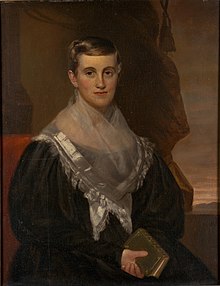Prudence Crandall | |
|---|---|
 Crandall, 1834 portrait by Francis Alexander | |
| Born | September 3, 1803 |
| Died | January 28, 1890 (aged 86) |
| Occupation | Teacher |
| Years active | 1830s |
| Known for | Canterbury Female Boarding School |
| Spouse | Calvin Philleo |
| Awards | State heroine of Connecticut |
| Academic background | |
| Education | Black Hill Quaker School |
| Alma mater | Moses Brown School |
| Academic work | |
| Institutions | Canterbury Female Boarding School |
| Notable ideas | Black girls had the same right to education as white girls. |
| Signature | |
Prudence Crandall (September 3, 1803 – January 27, 1890) was an American schoolteacher and activist. She ran the Canterbury Female Boarding School in Canterbury, Connecticut,[1] which became the first school for black girls ("young Ladies and little Misses of color") in the United States.
In 1832, when Crandall admitted Sarah Harris, a 20-year-old African-American woman, to her school,[2][3] she created what is considered the first integrated classroom in the United States.[4] Parents of the white children began to withdraw them.[2] Prudence was a "very obstinate girl", according to her brother Reuben.[5] Rather than ask the African-American student to leave, she decided that if white girls would not attend with the black students, she would educate black girls. She was arrested and spent a night in jail. Repeated trials for violating a Connecticut law passed to make her work illegal, as well as violence from the townspeople, resulted in Crandall being unable to keep the school open safely.[6] She left Connecticut and never lived there again.[2]
Much later the Connecticut legislature, with lobbying from Mark Twain, a resident of Hartford, passed a resolution honoring Crandall and providing her with a pension. Twain offered to buy her former Canterbury home for her retirement, but she declined.[7] She died a few years later, in 1890.[4]
In 1995 the Connecticut General Assembly named her the State Heroine of Connecticut.
- ^ Green, Arnold W. (January–March 1966). "Nineteenth Century Canterbury Tale". Phylon. 7 (1): 58–63. doi:10.2307/271285. JSTOR 271285.
- ^ a b c Wormley, G. Smith. The Journal of Negro History, "Prudence Crandall", Vol. 8, No. 1, January 1923, pp. 72–80. JSTOR 2713460
- ^ Tisler, C.C. "Prudence Crandall, Abolitionist", Journal of the Illinois State Historical Society (1908–1984), Vol. 33, No. 2, June 1940, pp. 203–206. JSTOR 40187935
- ^ a b Cite error: The named reference
Smallwas invoked but never defined (see the help page). - ^ The trial of Reuben Crandall, M.D. : charged with publishing seditious libels, by circulating the publications of the American Anti-Slavery Society, before the Circuit Court for the District of Columbia, held at Washington, in April, 1836, occupying the court the period of ten days. New York: H. R. Piercy. 1836. p. 35. Archived from the original on September 2, 2020. Retrieved March 10, 2020.
- ^ "State Heroine Prudence Crandall". ConnecticutHistory.org. September 3, 2020. Archived from the original on November 29, 2023. Retrieved April 2, 2024.
- ^ "Prudence Crandall and the Canterbury Female Boarding School". Country Cultures. May 15, 2011. Archived from the original on July 20, 2019. Retrieved July 15, 2019.